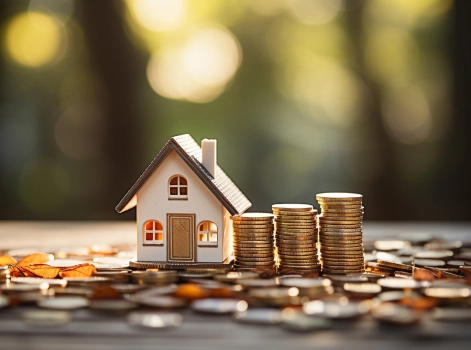At its core, negative gearing refers to a situation, where your investment property is costing you more to hold than it’s bringing in through rent.
That might sound like bad news, but here’s the twist: that loss could actually save you money come tax time.
So, how does it exactly work? Let’s find out.
Negative Gearing Explained
The term gearing simply means borrowing to invest.
If you’ve taken out a loan to buy a rental property, your investment is considered geared.
There are two main types:
- Negative Gearing: when your property costs more to hold than it earns in rent.
- Positive Gearing: when your property earns more in rent than it costs you to hold.
Let’s say you buy an apartment for $300,000 in an up-and-coming suburb. You charge $300 a week in rent, but your mortgage, insurance, and management costs total $400 per week. That’s a $100 weekly shortfall.
Over the year, that adds up to a $5,200 loss.
Here’s where it gets interesting: that $5,200 can be deducted from your taxable income, potentially reducing your tax bill. The goal is to ride out the short-term loss and wait for the property’s value to grow (capital growth), so you come out ahead when you eventually sell.
Want to crunch the numbers for yourself? Use our negative gearing calculator to see how this strategy could stack up in your situation.
How Does Negative Gearing Work?
Here’s how you Negative gearing works from a financial perspective:
1. Add up your rental income
This includes everything you earn from tenants over the financial year.
2. Calculate your expenses
This can be mortgage interest, property management, maintenance, insurance, council rates, everything.
3. Subtract expenses from income
If expenses are higher than your income, you’ve got a net loss, and that’s where negative gearing kicks in.
For instance,
- Rental income = $25,000
- Expenses = $35,000
- Net loss = -$10,000
4. Claim the loss on your tax return
If you earned $100,000 from your job, that $10,000 property loss reduces your taxable income to $90,000. At a marginal tax rate of 30%, that’s $3,000 less tax you’ll need to pay.
Why Do People Use Negative Gearing?
For Australian investors, negative gearing plays a key role in a long-term wealth building strategy.
There are primarily two reasons for using negative gearing:
- You can claim losses on your tax, including depreciation. So, when tax season rolls around, you reduce your taxable income.
- Negative gearing can help you see a good return on your investment in the long run. With just a bit of lock, you can typically get a capital gain that far outweighs any losses you might have been accrued.
Risks Associated With Negative Gearing
Tax perks and capital growth is indeed appealing, but negative gearing isn’t a guaranteed win. Here are some questions every investor should ask:
- What happens if you can’t find tenants for a few months?
- What if property values dip and your asset doesn’t appreciate as expected?
- What if interest rates spike and you can’t increase rent to cover the cost?
These are realities every investor must consider. A loss is still a loss, even if it comes with a tax deduction.
How to minimise these risks?
You can minimise these risks by:
Choosing the Right Property
Location is everything. Choose a property near schools, transport, shops, or employment hubs. These are the areas that consistently attract tenants. The goal is to keep your property occupied and reduce vacancy risk.
Being Honest About Your Income
Before you invest, be honest about your income to see if you can cover the property’s shortfall, even if unexpected expenses pop up. You will need enough surplus to ride out vacancies or urgent repairs without
Getting An Insurance
You can get landlord insurance, income protection, and even trauma cover. You can speak to your broker or adviser about what suits your situation.
How Positive Gearing Works?
Positive gearing happens when your rental income exceeds your property’s expenses, which means you are making a profit.
This leads to the profit being taxed.
Here’s an example:
- You earn $20,000 in rent per year.
- You spend $15,000 on expenses.
The $5,000 profit is added to your taxable income and taxed accordingly.
Positive gearing offers immediate income, improved cash flow, and can boost your borrowing power, but it typically comes with lower capital growth, especially if you’re investing in rural or regional areas.
Final Words
Negative gearing can be beneficial only if it fits your financial situation and risk tolerance. Before you make a move, speak to a mortgage broker or financial adviser, who can help tailor the right plan for your investment.
Take the Next Step in Your Property Investment Plan
Make your property investment count with expert guidance from Home Loan Experts. We find competitive rates and tailored loan solutions. Secure your ideal loan today!
Learn MoreFrequently Asked Questions
How Does Negative Gearing Affect Housing Affordability?
Negative gearing drives property investment and higher prices, which reduces affordability for first-home buyers. Its effects are mixed on rents, with debate over supply and potential rent increases. Experts recommend reform not removal ideas include limiting deductions, raising capital gains tax, aiding first-home buyers, and boosting public housing to improve affordability.
How Does Negative Gearing Affect Tax Returns?
Still need answers? We're here to help!
Ask an expertOur team of mortgage experts will assist you within 24 hours.
